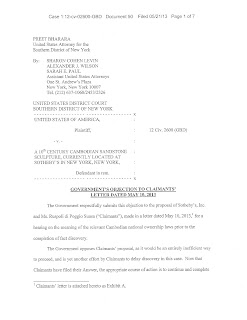Sotheby’s wants a preliminary hearing to argue the law, and the government wants more discovery from Sotheby’s to argue the facts. That continues to be the posture of the case of
United States of America v. A 10th Century Cambodian Sandstone Sculpture Currently Located at Sotheby’s.
Yesterday federal prosecutors criticized Sotheby’s and Decia Ruspoli di Poggio Suasa, claimants in the forfeiture case, for “yet another effort to delay discovery in the case.” The U.S. Attorney’s Office for the Southern District of New York objected to a letter recently submitted by the claimants that requests a pre-discovery hearing to discuss the meaning of Cambodia’s cultural property ownership law.
Prosecutors write that the claimants “should not be permittedto delay [the case] further by being granteda hearing on an issue that will not resolvethe case.” They argue that “the appropriate course of action is to continue and complete fact discovery on all issues in the case.”
The claimants disagree, explaining that the issue of whether Cambodia’s law declares ownership over the statue is a matter the court should consider before the claimants provide further information to prosecutors. In their May 10 letter to the federal district court, Sotheby’s and Decia Ruspoli di Poggio Suasa write that the issue of whether Cambodia owns the statue is a matter of law, not fact, which the judge must address rather than a jury.
But federal lawyers counter that the question of whether the Duryodhana sculpture from the Prasat Chen temple at Koh Ker is owned by Cambodia and was stolen from that nation turns on the facts as well as the law.
Prosecutors make the two-pronged assertion that “Cambodia declared itself the owner of the Statue through its clear and unambiguous national ownership laws” and that “Cambodia acquired the Statue in the ‘general manner’ and that the Statue was then stolen from Cambodia ‘in the commonly used sense of the word.'”
The McClain/Schultz doctrine, the prosecutors argue, supports the proposition that a cultural patrimony law is one way by which a nation can own cultural material. And Cambodia’s national ownership law is clear, they maintain. “Claimants disputeonly that Koh Ker and the Prasat Chen temple were, in fact, part of the national or colonial domain.” This dispute, prosecutors stress, “involve[s] factual questions that are mattersfor summary judgmentor trial.”
Prosecutors also assert that the second way that Cambodia owns the Duryodhana statue is through the general understanding of what it means to steal:
But Schultz and McClain certainly do not stand for the proposition that a state can never “own” an object in the absence of a national ownership law. Rather, McClain makes clear that a state can come to own property either by “declar[ing] itself the owner” through a national ownership law, or by “acquir[ing] such property in the general manner by which private persons come to own property.” McClain, 545 F.2d at 1002. And Schultz, in adopting the reasoning of McClain, plainly contemplated that an object could be “stolen” not only by virtue of having been “possessed or disposed of by an individual in violation of a national patrimony law,” but also “‘stolen’ in the commonly used sense of the word, for instance, where an object is taken from a museum or a private collection.” 333 F.3d at 399.
Prosecutor allege that the monuments of Koh Ker were built by Cambodia state under Jayavarman IV, that the state never transferred Koh Ker or the statue to anyone, that looters stole the statue in 1972 and trafficked it in pieces to Thailand, and that a well-known collector purchased it knowing that it was stolen. “These factual allegations … do not depend upon an analysis of Cambodia’s national ownership laws ….,” the prosecutors contend.
In an effort to press for disclosure of information from Sotheby’s, the U.S. Attorney’s Office avers that
it
would
be
most
efficient
to
conduct
discovery
on
all
factual
issues
in
this
action
simultaneously,
as
the
discovery
will
be
largely
overlapping.
Evidence
regarding
the
Collector,
for
instance,
will
be
relevant
not
only
to
the
issue
of
whether
the
Statue
was
stolen
from
Cambodia,
but
also
to
the
issue
of Sotheby’s
knowledge
of the
theft,
as
the
Amended Complaint allegesthat Sotheby’s “consulted regularly with the Collector regardingthe sale of the [Statue],” that Sotheby’s “knowingly omitted the Collector’s acquisition of the [Statue]from the provenance information it provided,” and that Sotheby’s was informed by “a scholar of Khmer art closely associated with the Collector (the “Scholar”)” that the Statue was stolen.
The claimant’s, however, are resisting this push. That is why they request that “the Court schedule a pretrialconference pursuant to Rule 16 of the Federal Rules of Civil Procedure to discuss appropriate procedures for reaching resolution on what is likely to be the dispositive issue in this case: whether any of the French colonial decrees the Government has identified clearly and unambiguously declare Cambodiato be the owner of the statue at issue in this case.”
This post is researched, written, and published on the blog Cultural Heritage Lawyer Rick St. Hilaire at
culturalheritagelawyer.blogspot.com. Text copyrighted 2010-2013 by Ricardo A. St. Hilaire, Attorney & Counselor at Law, PLLC. Any unauthorized reproduction or retransmission of this post is prohibited. CONTACT INFORMATION:
www.culturalheritagelawyer.com©2010-2022 Cultural Heritage Lawyer Rick St. Hilaire. Content discussing cultural heritage law, art law, looted antiquities, stolen artifacts, and museum risk management that is general information only, not legal advice.


